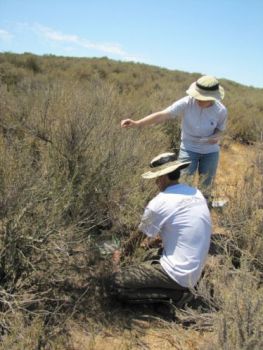Jan 28 2014
Initial results from experiments conducted in the Santa Monica Mountains by a botanist at the University of California, Riverside and her colleagues indicate that high levels of nitrogen may adversely impact native plants and, by extension, increase the risk of wildfire.
 Interns measure plots of California sagebrush that have been injected with various levels of nitrogen as part of a three-year study to learn how air pollution is impacting native plants and fire risk. (Photo credit: National Park Service.)
Interns measure plots of California sagebrush that have been injected with various levels of nitrogen as part of a three-year study to learn how air pollution is impacting native plants and fire risk. (Photo credit: National Park Service.)
The researchers measured atmospheric nitrogen deposition levels at ten sites throughout the Santa Monica Mountains and found significantly higher pollution levels in the eastern end, closer to Los Angeles.
Generally attributed to vehicle emissions in the Santa Monica Mountains, nitrogen deposition is the air pollution from industry, agriculture and transportation that settles out of the atmosphere and onto the earth’s surface.
The study is helping the scientists better understand how high nitrogen levels affect native vegetation and what that might mean for fire risk in such a fire-prone region.
“Invasive annual grasses from the Mediterranean have a greater growth response to nitrogen than most native species, and are crowding out native plants,” said Edith Allen, a professor of plant ecology and cooperative extension specialist at UC Riverside, and the principal investigator for the study. “Grasses also produce fine, flashy fuels that cause more frequent and larger fires, promoting vegetation-type conversion from native shrubland to exotic annual grassland.”
The preliminary results are from the first year of a three-year study undertaken by Allen, Irina Irvine, a restoration ecologist for Santa Monica Mountains National Recreation Area, and Andrzej Bytnerowicz and Mark Fenn of the U.S. Forest Service.
At the two sites with the best air quality, the researchers added various levels of nitrogen fertilizer into experimental plots of coastal sage scrub to simulate pollution levels found throughout the mountains. They found that the higher levels of nitrogen led to a decline in native shrub seedlings and an increase in nonnative grasses.
Other studies in Australia and California have demonstrated a link between nonnative grasses, also known as “flashy fuels,” and larger and more frequent wildfires.
“The recent fire of May 2013 burned our research plots, but provides an opportunity to learn how invasive grasses compete with native seedlings establishing post fire under nitrogen deposition,” Allen said. “The data will enable us to determine critical loads of nitrogen deposition to help set clean air regulations to protect native ecosystems.”
Coastal sage scrub once covered much of coastal California and is now an endangered habitat type, primarily due to development.
Funded by the National Park Service’s Air Resources Division, the $100,000 study will help the scientists better determine the “critical load” when vegetation shifts, causing alterations to the structure and functionality of ecosystems.